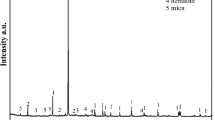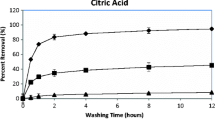Abstract
Purpose
Batch extraction experiments were conducted to investigate the chemical washing of metal-contaminated paddy soils using mixtures of ferric chloride (FeCl3) and citric acid (CTA).
Materials and methods
The effects of the extractants (FeCl3, CTA, or FeCl3 + CTA) and washing cycles (single-step or multistep washing) on the metal removal efficiency were studied. FeCl3 + CTA increased metal removal efficiency to some extent compared to single FeCl3 or CTA. When the liquid-to-solid ratio was 2:1 with three washes and two rinses, a mixture of 10 mmol L−1 FeCl3 and 20 mmol L−1 CTA removed 78.9% Cd, 15.8% Cu, 34.0% Zn, and 18.1% Pb from a Typic Fe–accumuli–Stagnic Anthrosols. Using multistep washing instead of single-step increased the metal extraction effect. Moreover, the removal efficiency and speciation of metals in different soils and changes in soil properties in washed soils were also studied.
Results and discussion
The removal rate of Cd was higher than that of Zn, Cu, or Pb because of the higher proportions of acid-soluble forms of Cd in the soils. The removal of metals from different soils depended on the distribution of metal speciation and soil type. Soil pH, CEC, exchangeable Ca, and exchangeable Mg decreased significantly after soil washing.
Conclusions
We conclude that chemical washing of metal-contaminated paddy soils with mixtures of FeCl3 and citric acid may be a feasible technique for soil remediation.



Similar content being viewed by others
References
Arwidsson Z, Elgh-Dalgren K, von Kronhelm T, Sjoberg R, Allard B, van Hees P (2010) Remediation of metal contaminated soil washing residues with amino polycarboxylic acids. J Hazard Mater 173:697–704
Bao SD (1996) Soil agrochemical analysis. China Agriculture Press, Beijing
Begum ZA, Rahman IMM, Tate Y, Sawai H, Maki T, Hasegawa H (2012) Remediation of toxic metal contaminated soil by washing with biodegradable aminopolycarboxylate chelants. Chemosphere 87:1161–1170
Chu BB, Luo LQ (2010) Evaluation of metal pollution in soils from Nanjing Qixiashang lead-zinc mine. Rock Miner Anal 29:5–8
Dermont G, Bergeron M, Mercier G, Richer-Lafleche M (2008) Soil washing for metal removal: a review of physical/chemical technologies and field applications. J Hazard Mater 152:1–31
Elliott HA, Shastri NL (1999) Extractive decontamination of metal-polluted soils using oxalate. Water Air Soil Poll 110:335–346
Finzgar N, Lestan D (2007) Multi-step leaching of Pb and Zn contaminated soils with EDTA. Chemosphere 66:824–832
Gaber MSRM. Seleem E (2011) Extraction of certain heavy metals from sewage sludge using different types of acids. Nigerian Society for Experimental Biology 23:41-48
GB15618-1995 (1995) Environmental quality standards for soils. State Bureau of Environmental Protection, State Bureau of Technical Supervision, Bejing
Gong ZT (2007) Pedogenesis and soil taxonomy. Science Press, Beijing
Hu P, Yang B, Dong C, Chen L, Cao X, Zhao J, Wu L, Luo Y, Christie P (2014) Assessment of EDTA heap leaching of an agricultural soil highly contaminated with metals. Chemosphere 117:532–537
Impellitteri CA, Saxe JK, Cochran M, Janssen GMCM, Allen HE (2003) Predicting the bioavailability of Cu and Zn in soils: modeling the partitioning of potentially bioavailable Cu and Zn from soil solid to soil solution. Environ Toxicol Chem 22:1380–1386
Jan FA, Ishaq M, Ihsanullah I, Asim SM (2010) Multivariate statistical analysis of metals pollution in industrial area and its comparison with relatively less polluted area: a case study from the City of Peshawar and district Dir Lower. J Hazard Mater 176:609–616
Jean-Soro L, Bordas F, Bollinger JC (2012) Column leaching of chromium and nickel from a contaminated soil using EDTA and citric acid. Environ Pollut 164:175–181
Jelusic M, Lestan D (2014) Effect of EDTA washing of metal polluted garden soils. Part I: toxicity hazards and impact on soil properties. Sci Total Environ 475:132–141
Jelusic M, Grcman H, Vodnik D, Suhadolc M, Lestan D (2013) Functioning of metal contaminated garden soil after remediation. Environ Pollut 174:63–70
Jiuyu Li, Renkou Xu, Diwakar Tiwari, Guoliang Ji, (2006) Effect of low-molecular-weight organic acids on the distribution of mobilized Al between soil solution and solid phase. Applied Geochemistry 21(10):1750-1759
Kedziorek MAM, Dupuy A, Bourg ACM, Compere F (1998) Leaching of Cd and Pb from a polluted soil during the percolation of EDTA: laboratory column experiments modeled with a non-equilibrium solubilization step. Environ Sci Technol 32:1609–1614
Kuo S, Lai MS, Lin CW (2006) Influence of solution acidity and CaCl2 concentration on the removal of metals from metal-contaminated rice soils. Environ Pollut 144:918–925
Lee M, Paik IS, Do W, Kim I, Lee Y, Lee S (2007) Soil washing of As-contaminated stream sediments in the vicinity of an abandoned mine in Korea. Environ Geochem Health 29:319–329
Li HB, Yu S, Li GL, Liu Y, Yu GB, Deng H, Wu SC, Wong MH (2012) Urbanization increased metal levels in lake surface sediment and catchment topsoil of waterscape parks. Sci Total Environ 432:202–209
Li YJ, Hu PJ, Zhao J, Dong CX (2014) Remediation of cadmium- and lead-contaminated agricultural soil by composite washing with chlorides and citric acid. Environ Sci Pollut Res. doi:10.1007/s11356-11014-13720-z
Maas S, Scheifler R, Benslama M, Crini N, Lucot E, Brahmia Z, Benyacoub S, Giraudoux P (2010) Spatial distribution of metal concentrations in urban, suburban and agricultural soils in a Mediterranean city of Algeria. Environ Pollut 158:2294–2301
Makino T, Sugahara K, Sakurai Y, Takano H, Kamiya T, Sasaki K, Itou T, Sekiya N (2006) Remediation of cadmium contamination in paddy soils by washing with chemicals: selection of washing chemicals. Environ Pollut 144:2–10
Makino T, Takano H, Kamiya T, Itou T, Sekiya N, Inahara M, Sakurai Y (2008) Restoration of cadmium-contaminated paddy soils by washing with ferric chloride: Cd extraction mechanism and bench-scale verification. Chemosphere 70:1035–1043
Qin F, Shan XQ, Wei B (2004) Effects of low-molecular-weight organic acids and residence time on desorption of Cu, Cd, and Pb from soils. Chemosphere 57:253–263
Rauret G, Lopez-Sanchez JF, Sahuquillo A, Rubio R, Davidson C, Ure A, Quevauviller P (1999) Improvement of the BCR three step sequential extraction procedure prior to the certification of new sediment and soil reference materials. J Environ Monitor 1(1):57–61
Rauret G, Lopez-Sanchez JF, Sahuquillo A, Barahona E, Lachica M, Ure AM, Davidson CM, Gomez A, Luck D, Bacon J, Yli-Halla M, Muntau H, Quevauviller P (2000) Application of a modified BCR sequential extraction (three-step) procedure for the determination of extractable trace metal contents in a sewage sludge amended soil reference material (CRM 483), complemented by a three-year stability study of acetic acid and EDTA extractable metal content. J Environ Monitor 2:228–233
Shao X, Cheng HG, Duan XL, Lin CY (2013) Concentrations and chemical forms of metals in agricultural soil near the world’s largest and oldest tungsten mine located in China. Chem Spec Bioavailab 25:125–132
Theodoratos P, Papassiopi N, Georgoudis T, Kontopoulos A (2000) Selective removal of lead from calcareous polluted soils using the Ca-EDTA salt. Water Air Soil Poll 122:351–368
Torres LG (2012) Removal of As, Cd, Cu, Ni, Pb, and Zn from a highly contaminated industrial soil using surfactant enhanced soil washing. Phys Chem Earth 37-39:30–36
Tuin BJW, Tels M (1990) Extraction kinetics of 6 heavy-metals from contaminated clay soils. Environ Technol 11:541–554
Udovic M, Lestan D (2012) EDTA and HCl leaching of calcareous and acidic soils polluted with potentially toxic metals: remediation efficiency and soil impact. Chemosphere 88:718–724
Voglar D, Lestan D (2012) Pilot-scale washing of metal contaminated garden soil using EDTA. J Hazard Mater 215:32–39
Wen J, Stacey SP, McLaughlin MJ, Kirby JK (2009) Biodegradation of rhamnolipid, EDTA and citric acid in cadmium and zinc contaminated soils. Soil Biol Biochem 41:2214–2221
Yoo JC, Lee CD, Yang JS, Baek K (2013) Extraction characteristics of metals from marine sediments. Chem Eng J 228:688–699
Zhai LM, Chen TB, Liao LY, Yan XL, Wang LX, Xie H (2008) Pollution of agricultural soils resulting from a tailing spill at a Pb-Zn mine: a case study in Huanjiang, Guangxi Province. Acta Sci Circumst 28:1206–1211
Zhu QH, Huang DY, Liu SL, Luo ZC, Rao ZX, Cao XL, Ren XF (2013) Accumulation and subcellular distribution of cadmium in ramie (Boehmeria nivea L. Gaud.) planted on elevated soil cadmium contents. Plant Soil Environ 59:57–61
Zupanc V, Kastelec D, Lestan D, Grcman H (2014) Soil physical characteristics after EDTA washing and amendment with inorganic and organic additives. Environ Pollut 186:56–62
Acknowledgements
This work was jointly supported by the Natural Science Foundation of Jiangsu Province (BE20130711) and the National Natural Science Foundation of China (41325003).
Author information
Authors and Affiliations
Corresponding author
Additional information
Responsible editor: Richard K. Shaw
Rights and permissions
About this article
Cite this article
Gao, J., Zhao, J., Dong, C. et al. Remediation of metal-contaminated paddy soils by chemical washing with FeCl3 and citric acid. J Soils Sediments 18, 1020–1028 (2018). https://doi.org/10.1007/s11368-017-1759-4
Received:
Accepted:
Published:
Issue Date:
DOI: https://doi.org/10.1007/s11368-017-1759-4




